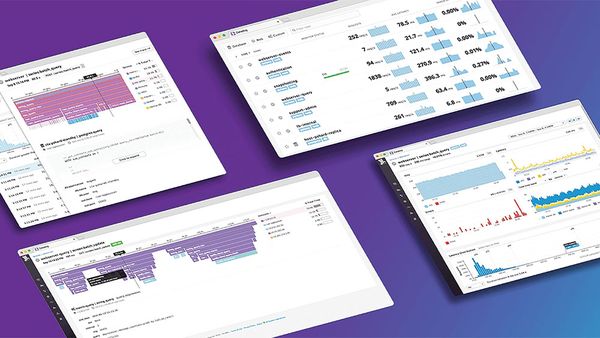The corporate spending slump prompted growth stock investors to hit pause on cloud computing companies that charge customers based on the resources they consume, instead of a monthly subscription. Now, the tide may be turning as investors take a fresh look at consumption-based software providers.
This was underscored on Nov. 7 when shares of Datadog jumped on the cloud data-management software company's stronger-than-expected outlook. The report triggered a rally in shares of Snowflake and MongoDB, major cloud software players that, like Datadog, embraced consumption-based pricing.
For investors in software stocks, which generally offer higher revenue growth these days, the rally highlights a key question about software-as-a-service, or SaaS, companies: Is it better to own shares in a traditional SaaS player — or one that embraces a fairly new flavor of SaaS focused on consumption-based pricing?
Growth Stock Investors Eye A New SaaS Flavor
Traditional SaaS vendors, led by Salesforce.com, charge fixed monthly or annual subscription fees based on the number of users. Newer players, led by Snowflake, charge clients based on how much software they use. Cloud companies are gearing up for even more changes with the rapid rise of artificial intelligence.
In a bull market, "the consumption names were the names to own," TD Cowen analyst Derrick Wood told Investor's Business Daily. "That's because every incremental piece of booking or consumption was immediate upside to numbers. That's why the valuations went up so much."
"But in a market correction there's a lot more predictability in the (traditional) SaaS model," he added. "It kind of depends on where we are in a market cycle. There could be a rotation in investors wanting to own consumption-based models if the economy accelerates, if there's a market upturn. For now, it's a balance. (Big Data) is still a very nascent market and there's a long runway to go."
Benefits Of Consumption-Based Pricing
In a note to clients, TD Cowen analyst Andrew Sherman said consumption-based SaaS players offer a pricing model with "many benefits, including no shelfware (very customer friendly), no per-user pricing that is affected by seat cuts, and the ability to grow much faster than traditional seat-based subscription software models during good times."
But "the negatives have been well telegraphed over the past year: what went up can come down in a hurry, resulting in a significant deceleration for all usage models."
Software-as-a-service has been a growing trend for more than two decades. The Covid crisis sparked even more growth in the SaaS market as tech companies rushed to support remote work and online consumer services.
But then the downturn hit. In mid-2022, major U.S. corporations began pulling back on information-technology spending, including for cloud computing services.
The slump highlighted key differences in the major pricing models. In good times, providers using consumption-based pricing saw more robust growth at a time when demand for their services is also stronger. But when the economy is weakening, subscription-based providers have one key advantage: It made their revenue growth easier to predict.
Software Growth Stocks: Spotlight On SNOW, CRM
The cloud software trends should become clearer in the coming weeks for growth stock investors with the earnings reports of two cloud software giants: Salesforce.com and Snowflake.
Snowflake, a provider of data analytics and management software, reports Nov. 29. Salesforce, an SaaS leader for over 20 years, reports earnings on Nov. 30. Shares in CRM stock are up 61% in 2023.
Salesforce charges clients fixed subscription fees on a "per seat" (per user) monthly or annual basis. On the other hand, Snowflake uses a consumption-based model in which customers buy credits upfront, say for $100,000. The credits are consumed based on actual usage of compute and cloud services.
The credits can be used up at any cadence that customers want over the duration of a contract. Snowflake recognizes product revenue as the credits are consumed. That's unlike traditional SaaS companies that usually recognize revenue fully when contracts are signed.
Snowflake is clearly looking to expand its reach. Early this year, the company committed to spending at least $2.5 billion at AWS over the next five years, giving it access to compute and cloud services at lower rates.
Cloud 'Optimization' Backlash
Like most in the tech industry, cloud companies also took a hit in the 2022 pullback in corporate IT spending. In the cloud market, the slump was referred to as a push toward "optimization." It essentially underscored the growing criticism of many cloud computing services as inefficient and expensive, which became evident during the Covid crisis. As another tech downturn took hold, corporations focused on optimizing their cloud spending.
The backlash led to slower revenue growth at the big three of cloud computing: Amazon Web Services, Microsoft Azure and Google Cloud. But the Q3 earnings season suggests cloud spending has stabilized, though there's still much uncertainty in the U.S. economy.
"With Microsoft, Google and Amazon having finished reporting Q3 results, the key takeaway from our perspective is that cloud growth at the aggregated hyperscaler level has finally stabilized after eight consecutive quarters of year-over-year declines," Morgan Stanley analyst Sanjit Singh said in a report.
Investors in SaaS stocks appeared jittery during the early part of November. Shares of consumption-based software companies sold off on disappointing guidance from Confluent.
But then came Datadog earnings, which featured a stronger-than-expected outlook. Shares of consumption-based SaaS companies rallied on the report.
With its recent rebound, DDOG stock has gained 39% in 2023. MongoDB has advanced 91%. Dynatrace is up 32%. JFrog has climbed 22%. Elastic is up 47%.
SNOW stock has gained about 11% in 2023, underperforming the Nasdaq composite, which is up nearly 33%
Consumption Model Niches
Snowflake, whose 2020 initial public offering was the largest ever by a software company, is expected to offer more insights into the state of SaaS when the company reports in two weeks.
The consumption-based pricing model is also becoming popular among cloud startups, including firms in the developer and operations space, known as Dev-Ops. One player, Databricks, a Snowflake rival, recently put its valuation at $43 billion in its latest funding round. The company is widely expected to go public in 2024.
But the subscription-model isn't going away. TD Cowen's Wood said that that pricing model will likely remain dominant "at the application layer — everything in CRM (customer relationship management), ERP (enterprise resource planning)."
In fact, there's a consensus that a hybrid model will likely be a key trend in cloud software, especially with the rise of a major trend: generative artificial intelligence.
The AI frenzy triggered by the introduction of ChatGPT last year has spread to the cloud market. Microsoft has attracted much attention as the biggest investor in OpenAI, the leader in generative AI. Microsoft earnings for the September quarter handily beat estimates as AI services boosted Azure cloud computing revenue.
At Microsoft's Azure cloud unit, consumption-based pricing is an option for customers building custom apps using OpenAI's training models.
Generative AI Software Pricing
The AI push is bound to raise an important issue among cloud players that is critical for growth stocks investors: how to price AI tools integrated into their platforms.
Salesforce is among software companies aiming to monetize new "generative" AI products.
"All the new generative AI capabilities will add somewhat of a sidecar for consumption-based pricing model to a lot of vendors," TD Cowen's Wood said. "Salesforce still very much per seat (SaaS) but they're adding some level of consumption pricing with their GPT solutions. I think a lot of companies will add a flavor of consumption."
"Adobe is giving some base level of credits (for AI Firefly tools) with a monthly per seat subscription. If you're a heavy user and go beyond the base level, then you have to buy more tokens. And, that based on consumption."
In fact, Gartner analyst Ed Anderson said he expects a mix of pricing models in SaaS.
"Most software companies are doing generative AI as effectively a licensing uplift to their existing products. That's what Microsoft has done with an additional charge per user. So customers pay a premium to get access to generative AI capabilities. There's also a consumption model — if you use it, you pay for it. It's too early to tell which will be the predominate model. We're seeing both in the market today."
Follow Reinhardt Krause on X, formerly called Twitter, @reinhardtk_tech for updates on 5G wireless, artificial intelligence, cybersecurity and cloud computing.










